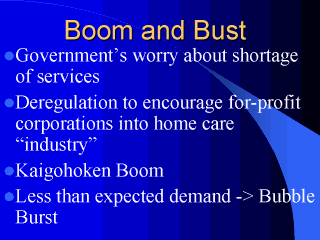| front |1 |2 |3 |4 |5 |6 |7 |8 |9 |10 |11 |12 |13 |14 |15 |16 |17 |18 |19 |20 |21 |22 |23 |24 |25 |26 |27 |28 |29 |30 |31 |32 |33 |34 |35 |36 |review |
 |
The anticipation of a
new system with estimated financial size of 4 trillion yen provoked a feverish excitement
not only in the health and welfare sector but also in the business community not directly
related to the LTC until then. Traditionally the market of medical care and welfare facilities has been closed to for-profit sector. The law precluded for-profit corporations or nonprofessional individuals from running hospitals or nursing homes based on the assumption that for-profit entrepreneurship may unduly exploit the right of patients and disabled people. However such a "not-for-profit" principle was largely loosened under the LTCI system at least in the field of home care [the principle is still held for institutional care]. For-profit corporations are rather encouraged to enter the home care market to boost the service supply. The ban of for-profit corporation to run independent visiting nursing stations [IVNS] was lifted in 1999. The result: many corporations scrambled to the bandwagon to catch the valuable opportunities in the long enduring economic slump. Training courses for home helpers were booked up and many companies waged large scale TV ads to catch customers. |